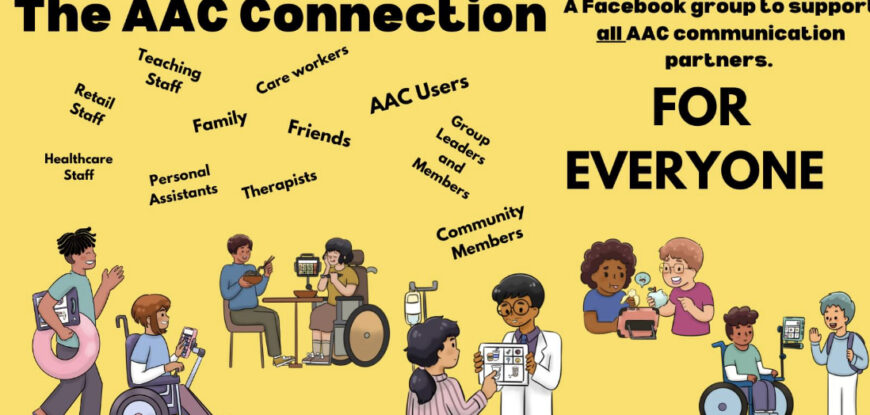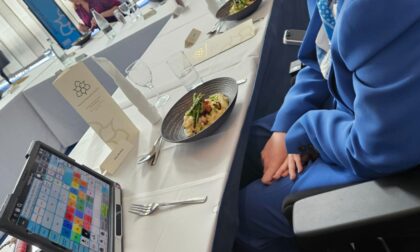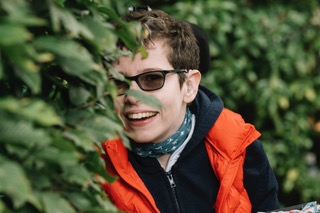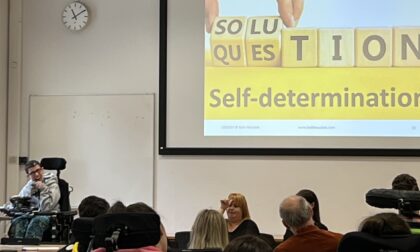Back in September 2023 a friend, Joanna Holmes (aka MummyvsAAC) and I got together to speak at the annual Communication Matters conference in Leeds. We had met at the 2022 conference and immediately discovered we had a lot in common. We had shared views about AAC users, communication partners and family life. Jo has a daughter, Lucy, who uses Augmentative and Alternative Communication (AAC) like me. Lucy and I are very different ages and our journey to date is also dissimilar. Nevertheless, Jo and I shared views and thoughts that were similar over a wide range of AAC-related topics. Our presentation was based on our shared passion to get people talking about communication partner skills. To round off our talk we wanted an ongoing dialogue so launched The AAC Connection on Facebook, please come and take a look.
Everyone is a communication partner
First and foremost, we believe that everyone who communicates is a communication partner. So, if you interact with an AAC user you are a communication partner. Also, this means by default if you are an AAC user you are also a communication partner. It’s quite simple really, we are all communication partners.
Family life is precious
From the outset, families play a big part as communication partners, especially for children who use AAC resources. Children are at home for more than two-thirds of their waking lives. This means we believe families need to be supported as communication partners. Much of the research around using AAC talks about constant modelling, mostly in schools. The premise of modelling is that the adult models use of the device at every opportunity. This focuses very much on the device being always available, which we agree is essential. Where we struggled more with the recommendations was feeling this can be too challenging to achieve in everyday family life. We need to recognise when a communication partner is stressed or tired, or needs a breather. I know when I was little I was beyond communicating when I got home from school, I was just exhausted and wanted to sleep. You can read more about families and AAC here.
Family magic
We believe it is important that there is balance in daily interactions. What families are good at are creating their own magic, and finding ways to be exceptional communication partners working within their own environment. A typical child doesn’t just speak when they are spoken to, unless you still live in Victorian times. Children live in communication-rich environments where not only do they speak, they observe, they mime and mimic. They learn to read body language, facial expressions, and eye rolls, they partake in family life and humour. And so too must every developing AAC user.
Within family life dynamics can change with an AAC user.
We introduced the AAC-saw model to explain what we meant by changing family dynamics for communication. Often when there is an AAC user we find, especially in formal settings, that the traditional speaking communication partner becomes the conversational lead. They ask questions, model, facilitate and interpret and the AAC user follows, answers questions, and demonstrates functional use. We want to recognise the need to change this to a more equal power balance between the AAC user and others. An environment that nurtures the AAC user to be more proactive and creative in their communication.
It is clear thought that achieving this isn’t always straightforward. One example that resonated for both of us is mealtimes. In many families this is the opportunity to interact, to have conversations, to practice giving and receiving information, sharing news, and discussing events. For AAC users, like me and Lucy, the mealtime focus can be functional, getting enough nutrition and eating safely. Access to our AAC resources is trickier over hot food, or with sticky hands, and with time constraints a meal may be pretty quiet. Mealtimes are mostly a completely different experience from other people’s norms.
By contrast, play times are often different too. In many homes a child will play independently, maybe exploring new things and possibly indulging in self-talk without adult supervision. A child using AAC often needs their play to be facilitated. This facilitation makes play more structured, and this becomes a time for both the AAC user and partner to model and practice communication skills. The AAC-saw means there are likely to be no fewer quality communication possibilities across each day, just differently structured opportunities.
People and skills as communication partners
People come in all shapes and sizes, and communication varies depending if communication partners are in your life for a reason, a season or for life. The AAC connection adds a different dynamic to interactions. As a result, we developed a people and skills map or model to explain what skills different communication partners need when interacting with AAC users.
At the bottom of our people triangle, the biggest level, we have the most diverse range of communication partners, those we come across in passing, maybe at the shops, or a restaurant. In the mid-level are those people we interact with regularly. At the apex or top of the triangle might be family, personal assistants and close friends.
If we then look at the corresponding inverted triangle we see the level of skills needed as communication partners. Most people really need to have good basic interaction skills that respect an AAC user and their chosen method of communication. In the mid-level, those people we come across more frequently, need a greater knowledge and skill level. This will include learning to be patient, to empower the speaker, and to employ the give-and-take of two-way communication. Then for those who are in close contact with the AAC user in their daily lives, there is a need for the most in-depth level of communication skills. This would include being familiar with a user’s AAC device and being active listeners. Having the knowledge and skills to support repairing conversational breakdowns and troubleshooting technical issues. Then becoming role models for others by demonstrating exceptional communication.
The AAC Connection
There is little formal training available for communication partners. What we wanted was a resource to support others ongoing. We want all communication partners to have the chance and opportunity to interact with like-minded people. To ask questions, to receive feedback and to provide support for these essential skills. Please come and join us at The AAC Connection on Facebook,
You can read more about communication partners here
If you want to explore this further with Jo and me then please email bethmoulam@aol.com





If you found this interesting or
helpful please feel free to share.